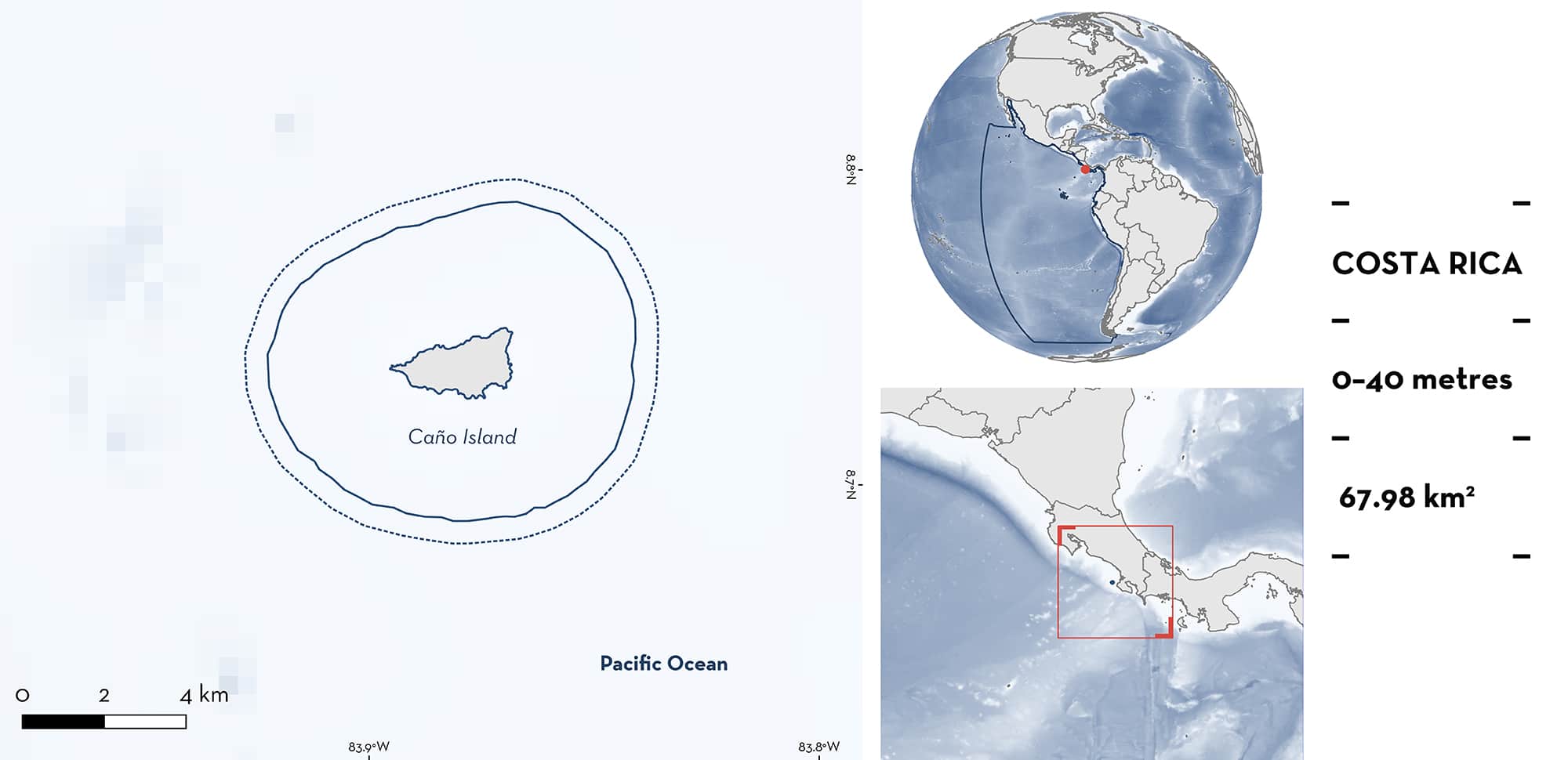ISRA FACTSHEETS
ISRA FACTSHEETS
CENTRAL AND SOUTH AMERICAN PACIFIC REGION
Caño Island
Summary
Caño Island is located around an inshore island 15 km off the coast of Costa Rica in the Eastern Tropical Pacific. It is a Biological Reserve with a marine no-take area. The area includes one of the most diverse coral reef formations on the Pacific coast of Costa Rica, characterised by five fringing coral reef flats. In this area there are: threatened species (Whitetip Reef Shark Triaenodon obesus); range restricted species (Leopard Round Ray Urobatis pardalis); and resting areas (Whitetip Reef Shark).
Download factsheet
Caño Island
DESCRIPTION OF HABITAT
Caño Island is a relatively small (3.2 km2) inshore island located 15 km off the coast of Puntarenas in Costa Rica. Situated in the Pacific Central-American Coastal Large Marine Ecosystem (LME), this area was declared a Biological Reserve (marine no-take area extent of 55.4 km2) in 1987. The island has one of the most diverse coral reef formations from the Pacific coast of Costa Rica, characterised by five fringing coral reef flats ranging in size from 0.008 to 0.042 km2 (Guzmán & Cortez 1989). Reefs are mainly formed by Lobe Coral Porites lobata and branching corals (Pocillopora spp.). The Honeycomb Coral Gardineroseris planulata, Superficial Coral Psammocora superficialis, and Pavona spp. reef-building species are also common. The shallow sections of the reef are structured mainly by physical factors (e.g., wave action, temperature and salinity fluctuations, and low tide exposure), whereas the deeper sections are influenced by biological interactions such as bioerosion, damselfish algal lawns, and corallivores (Guzmán and Cortes 1989, 2001; Naranjo-Arriola 2001; Guzmán et al. 2009).
This Important Shark and Ray Area is delineated from surface waters to a depth of 40 m based on the maximum depth range of the habitat used by the Qualifying Species.
CRITERION A
VULNERABILITY
One Qualifying Species considered threatened with extinction according to the IUCN Red List of Threatened SpeciesTM regularly occurs in the area. This is the Vulnerable Whitetip Reef Shark (Simpfendorfer et al. 2020).
CRITERION B
RANGE RESTRICTED
This area holds the regular presence of the Leopard Round Ray as a resident range-restricted species. This species is known to occur only in the Pacific Central-America Coastal LME. The Leopard Round Ray has been recorded year-round in the area and individuals are regularly encountered by local diving tour-operator companies (M. Cambra pers. comm. 2022). The presence of this species is also confirmed by Baited Remote Underwater Video Surveys (BRUVS) and Underwater Video Census (UVC) data from surveys conducted between 2017 and 2022 with 167 BRUVS and 80 UVS deployed during that period (Espinoza et al. 2020; M. Espinoza et al. unpubl. data). Between 2017–2019, BRUVS and UVS surveys were conducted in February (dry season). From 2020–2022, surveys were conducted two to three times per year, during the wet (June-November) and dry (December-May) seasons.
CRITERION C
SUB-CRITERION C3 – RESTING AREAS
Caño Island is an important resting area for one shark species. Whitetip Reef Sharks aggregate in groups of 6–15 individuals whilst resting on the substrate at Bajo del Diablo. These observations are primarily reported from surveys undertaken during the dry season (February), but local tour-operators regularly see aggregations of this species resting at this site year-round (M. Cambra pers. comm. 2022). Observations were also made from the 167 BRUVS and 80 UVS deployed between 2017 and 2022 (Espinoza et al. 2020; M. Espinoza et al. unpubl. data).
Download factsheet
SUBMIT A REQUEST
ISRA SPATIAL LAYER REQUEST
To make a request to download the ISRA Layer in either a GIS compatible Shapefile (.shp) or Google Earth compatible Keyhole Markup Language Zipped file (.kmz) please complete the following form. We will review your request and send the download details to you. We will endeavor to send you the requested files as soon as we can. However, please note that this is not an automated process, and before requests are responded to, they undergo internal review and authorization. As such, requests normally take 5–10 working days to process.
Should you have questions about the data or process, please do not hesitate to contact us.


